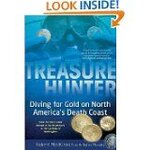Has anyone looked at Sable island which is a stones throw away? The Dennis was lost there in 1578 carrying all sorts of goodies and was never recovered. Or the Tillbury to the north in 1757. There are dozens of known gold bearing ships down in the area with no interest in them? My atlas of Shipwrecks shows countless wrecks all up and down the coast, in fact there appears to be more wealth lost in the water than there is currently on land.
Burbank, could you provide a link to the atlas of shipwrecks?





